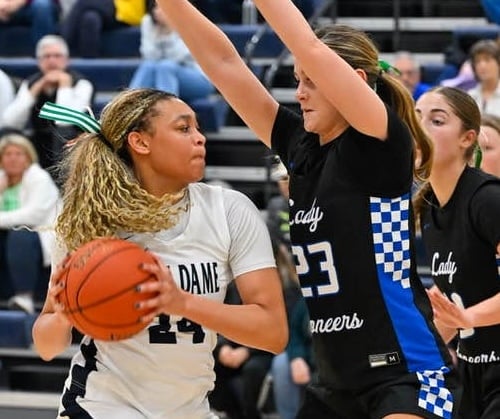Mention that you’ve seen a black squirrel to most Greater Cincinnatians and folks will think you’re color blind. In Ft. Mitchell though, you’ll find that just about everyone sees and even feeds black squirrels. We have two Ft. Mitchell residents to thank for those black squirrels.
Norbert Hellmann always enjoyed the squirrels at his home on Princeton Avenue in Ft. Mitchell. In 1970, while visiting relatives at Grosse Pointe Woods near Detroit, Norbert noticed an abundance of black squirrels. He trapped two black squirrels from Grosse Pointe Woods and released them at his Ft. Mitchell residence. Son-in-law Butch Wainscott trapped another while visiting the Detroit area on business. Those black squirrels thrived and bred with resident gray squirrels and produced more squirrels, gray and black.

The black squirrels being seen around Ft. Mitchell are really Eastern Gray Squirrels with a genetic mutation that causes excessive pigmentation or “melanism.” Biologists estimate that nationwide about one of every 10,000 gray squirrels is the black mutant.
Black-phase gray squirrels are by no means a genetic mistake. Gray squirrels in New England, Pennsylvania, Michigan and other northern states were almost all black before the days of early European settlers. The black fur more readily absorbs heat from the sun’s rays providing warmth during cold northern winters. Equally important, the black coloration is a defense mechanism.
Dr. Bill Hamilton, a biologist with Penn State New Kensington, explained, “Early northern forests were very primeval. They were very shaded, very dense and dark. It’s said that they were so dense that a squirrel could go from one end of the state to the other without ever touching the ground. The undisturbed North American population of gray squirrels was, according to historical records from the 1600’s and early 1700’s, predominately made up of black-phase gray squirrels due to the effectiveness of the black coloration as an aid in hiding from avian predators such as hawks or owls.”
As Europeans settled the New World, forests were cleared for farmland and squirrels were commonly hunted. Hamilton added, “As the continuous forests of Pennsylvania and on westward were broken up and the human hunting and bounty pressures on squirrels were increased, the black form of the gray squirrel, even though it is the genetically dominant variant, became less and less abundant. The black squirrel was very clearly outlined against the light colored sky when humans hunted squirrels from the forest floor. This human hunting pressure apparently favored the mixed gray coloration that even today predominates in most North American populations.”
Squirrels were not only a food source for early settlers; they were perceived as a serious threat to crops. Nearly all states in the northeast had bounties on squirrels. Hamilton explained, “In 1749 the Commonwealth of Pennsylvania put a 3-cent per skin bounty on gray squirrels to try to reduce the population. Over 640,000 pelts were turned in. In 1749 dollars, the outlay by Pennsylvania was huge, nearly bankrupting the state. In 1807 Ohio tried to reduce their squirrel population but also keep their state budget in tact by requiring each taxpayer to turn in squirrel pelts with their taxes in proportion to their tax bill. Each taxpayer had to turn in between 10 and 100 squirrel skins.”
Intense hunting pressures in northern states caused the black-phase squirrel to mutate to the now common gray color in a relatively short period of time. “The impact on gray squirrels was a classic example of natural selection that can take place over a period of only decades,” said Hamilton.
Times have changed and black squirrels are now revered with larger populations in Marysville, Kansas, Princeton, New Jersey, Galesburg, Illinois, New Hartford, Connecticut, Detroit and Lansing, Michigan.
About seven years after releasing his black squirrels, Norbert Hellmann passed away. In a fitting tribute, a lone black squirrel visited his yard on the day of his funeral. Norbert’s legacy lives on. All of the black squirrels we enjoy seeing in Ft. Mitchell, Ft. Wright, Crestview Hills, Lakeside Park, Edgewood and beyond can be traced to the three black squirrels that Norbert and Butch released in 1970.
Gayle Pille is a local naturalist and nature writer who many know through her work to establish the five-mile network of nature trails at Highland Cemetery in Ft. Mitchell. She created the cemetery’s popular 25-year-old Wildlife Enhancement Program and works with a small team of volunteers to maintain the cemetery’s wooded walking paths. An avid birdwatcher, Gayle also builds custom wildlife nest boxes for businesses, parks and residences through her business, www.woodlandhabitat.com
Contact her at gaylepille@yahoo.com



















I seen a black squirrel in Wilder Ky. 9/29/2022. Very pretty.
A couple years ago there was a black squirrel with a red tail that was hanging out in my yard for a couple months. He/she was beautiful!
/Users/laurelmiller/Desktop/IMG_3858.JPG
/Users/laurelmiller/Desktop/IMG_3858.JPG
We have a black squirrel family living here in Colonial Manor in Erlanger off Mineola Pike, for at least the last 18 years that I’ve lived here. Nice to know there are others in NKY